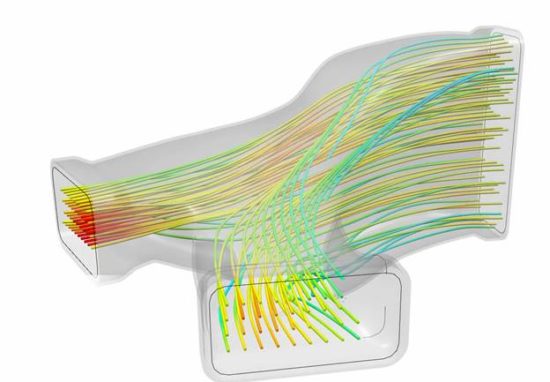Using tools already included in the 3DExperience portfolio, Dassault proposes a purpose-built generative design.

There is no doubt that generative design is changing the way parts are designed, modeled, and manufactured. That’s true, and it’s been true for over a decade. Unfortunately, the generative design has also introduced more complexity to the already complex interworkings of design/simulation/validation workflows.
Colin Swearingen, Dassault’s expert of generative design, says that even with the advancement of digitization siloes continue to exist through the process of design, simulation, optimization, and verification. With the introduction of its flow-driven generative design toolset, Dassault is proposing that generative design be streamlined for specific processes in a way that takes steps out of the process.
In the case of flow-driven generative design, Dassault’s engineers looked at fluid flow as a problem being dealt with powertrain engineers and designers, HVAC designers, jet propulsion engineers, injection molding specialists, or valve and piping designers. In Dassault’s demonstration of their toolset, they used the example of designing a duct for an automotive HVAC system. This area of design is ideal for generative design because the goals are well understood, and there are big benefits to be gained from design optimization to improve fuel efficiency, reduce emissions, etc. And, there’s room for improvement. Swearingen says that traditionally the process has involved a lot of disconnected tools to go through to generate a fluid design.
For Dassault, fluid flow is a good example because it’s complementary to their tool set which includes Catia tools for automotive design, Tosca fluid and structural simulation tools and the company’s 3DExperience architecture.
Dassault has released a webinar to describe their process. Key to the Dassault’s approach is that users can stay within a defined tool set without having to translate designs across tools. Everyone working on the problem can work with the same model. That’s one of the most important songs in Dassault’s 3DExperience hymn book.
Dassault’s approach gives the designer the ability to start with a design and then be able to follow pre-defined steps to setup for CFD and flow optimization, which eliminates some of the back and forth that was typical of the process. Swearingen says the new process gives everyone a common point of discussion.
Swearingen says the move to defined processes for generative design, which can take into consideration the mode of manufacture, be it additive, subtractive, molded or formed, is shaping up to be a huge trend, which will be happening more and more as tools and opportunities are defined.
What do we think?
Well yeah, Dassault is making a strong argument for the 3DExperience way of life. The company is moving to bring all its tools on to the same architectural platform so that they can be used intraoperatively. In the process, it’s also arguing that generative design will become more powerful as it becomes more targeted.
They’re not the only ones. Generative design is playing a huge role in the way software vendors are designing their products to make them more powerful for customers and all of the major design software vendors are angling to build a portfolio of tools that will enable customers to stay within the company’s family to accomplish as many tasks as possible. Dassault has always been extremely forthright about their belief that a homogeneous platform has measurable advantages for customers as well as for Dassault. Flow-driven generative design is a perfect example.
While customers might get uncomfortable with the idea of being corralled into a company’s entire tool set, they’re likely to be receptive to an integrated toolset that solves a specific but difficult problem.





